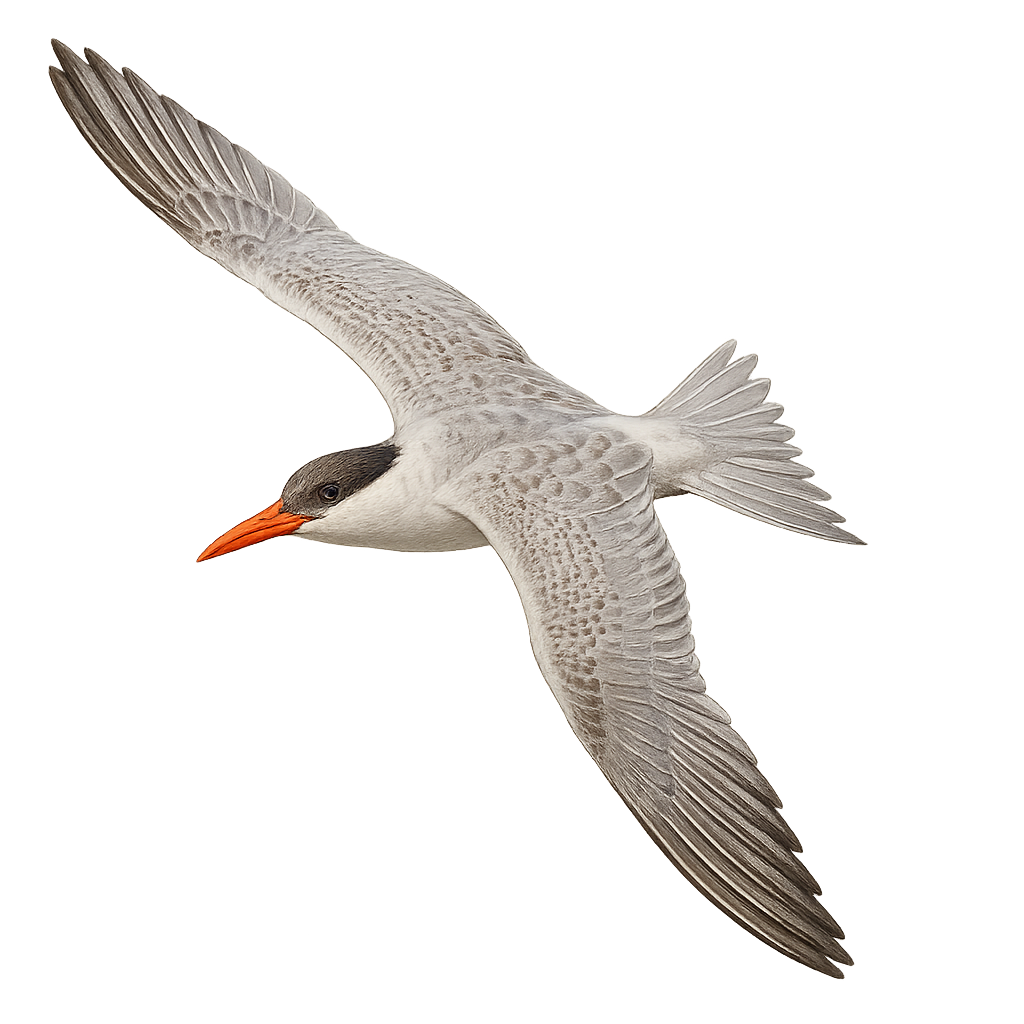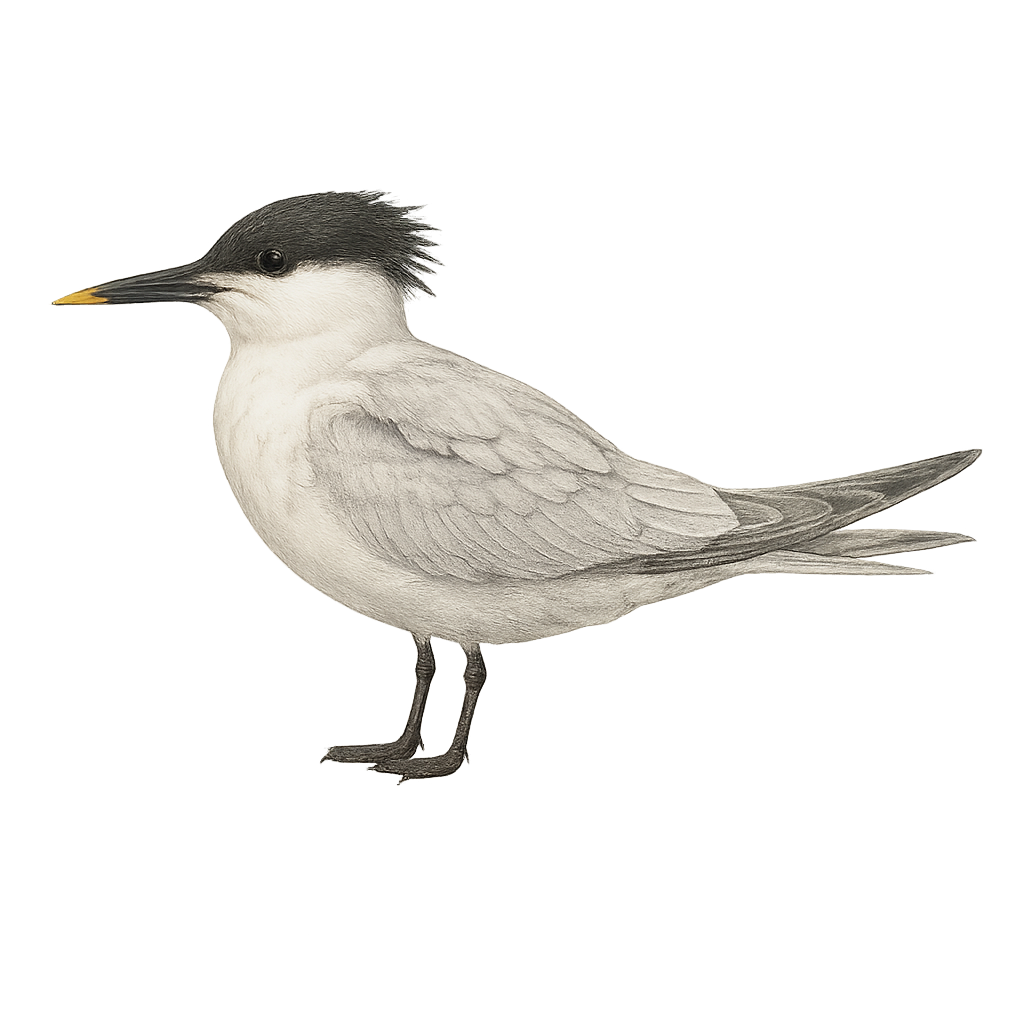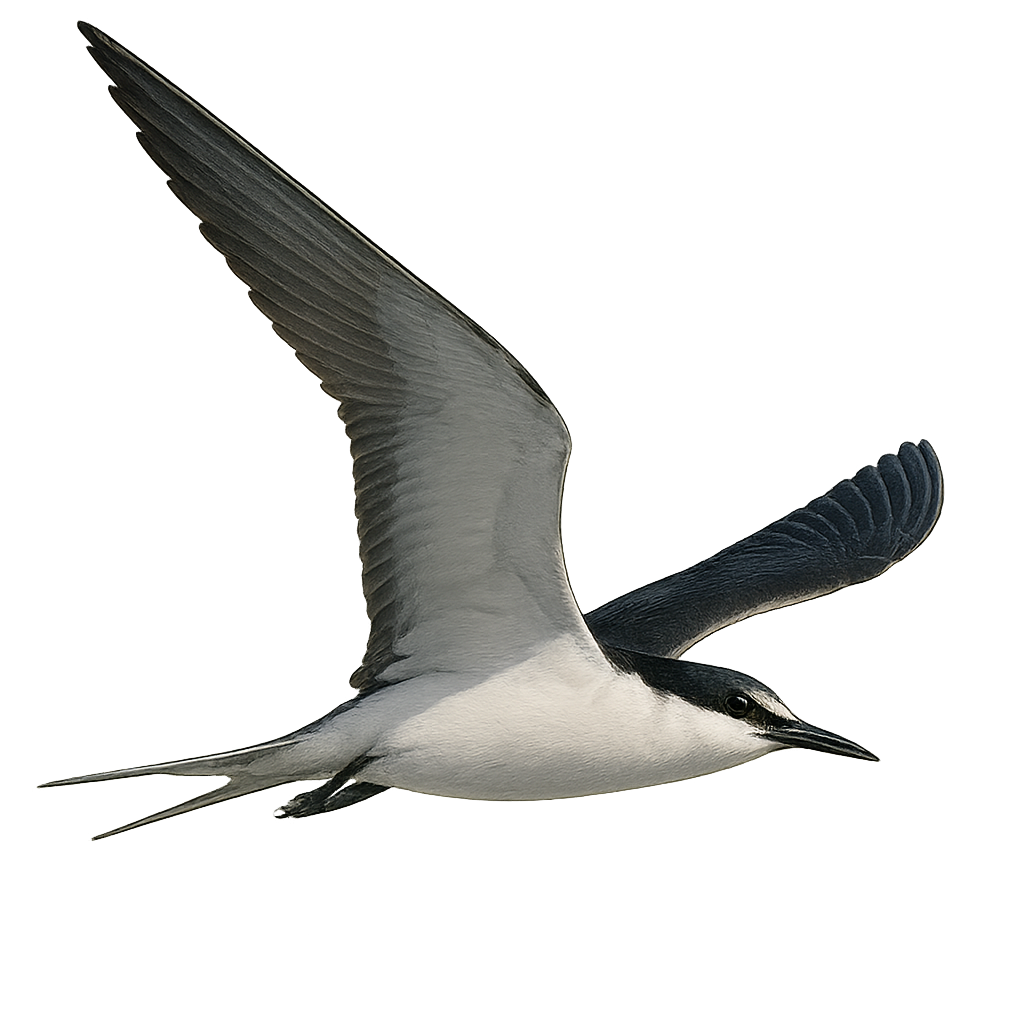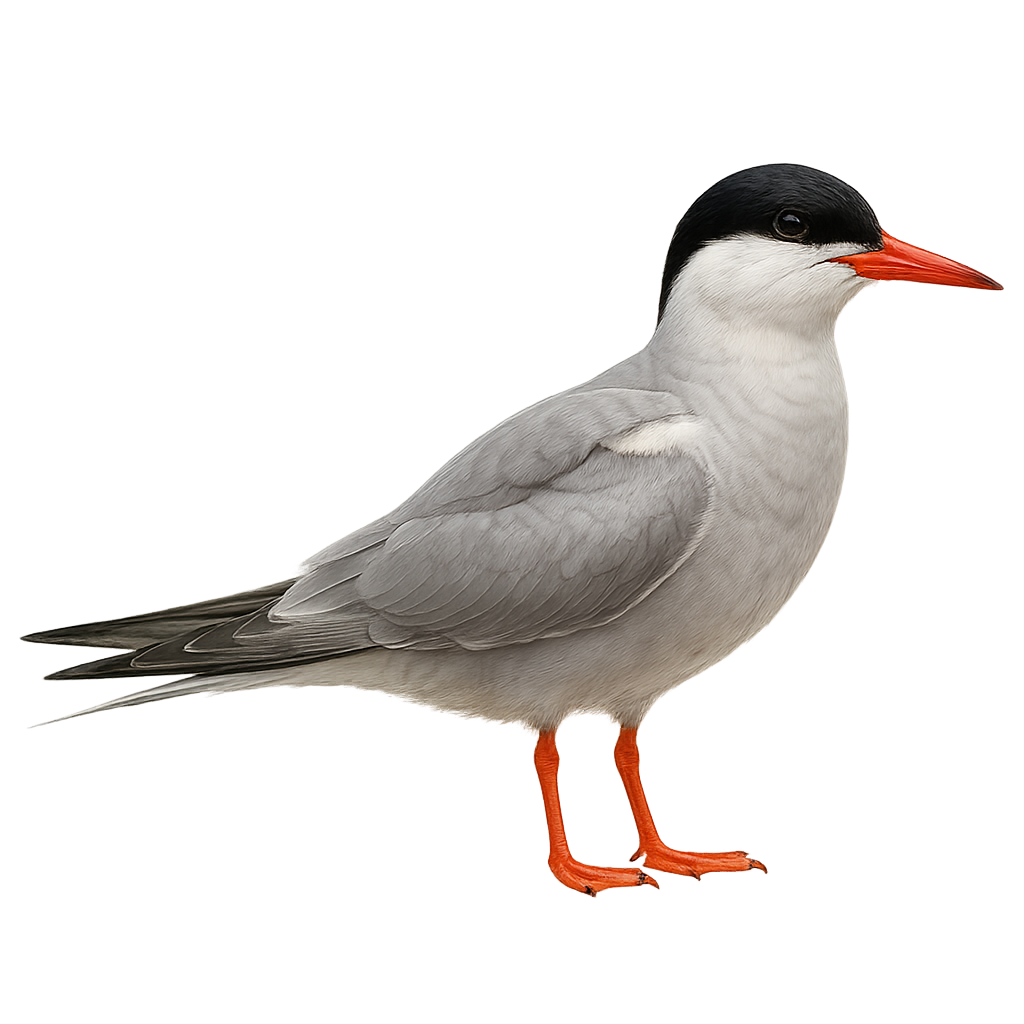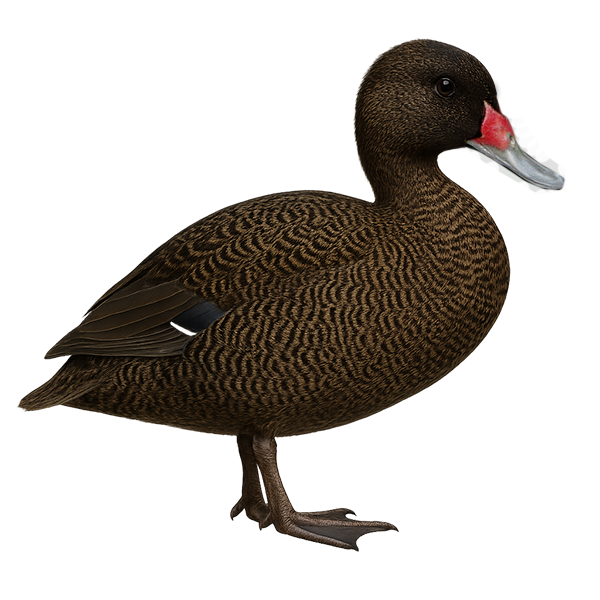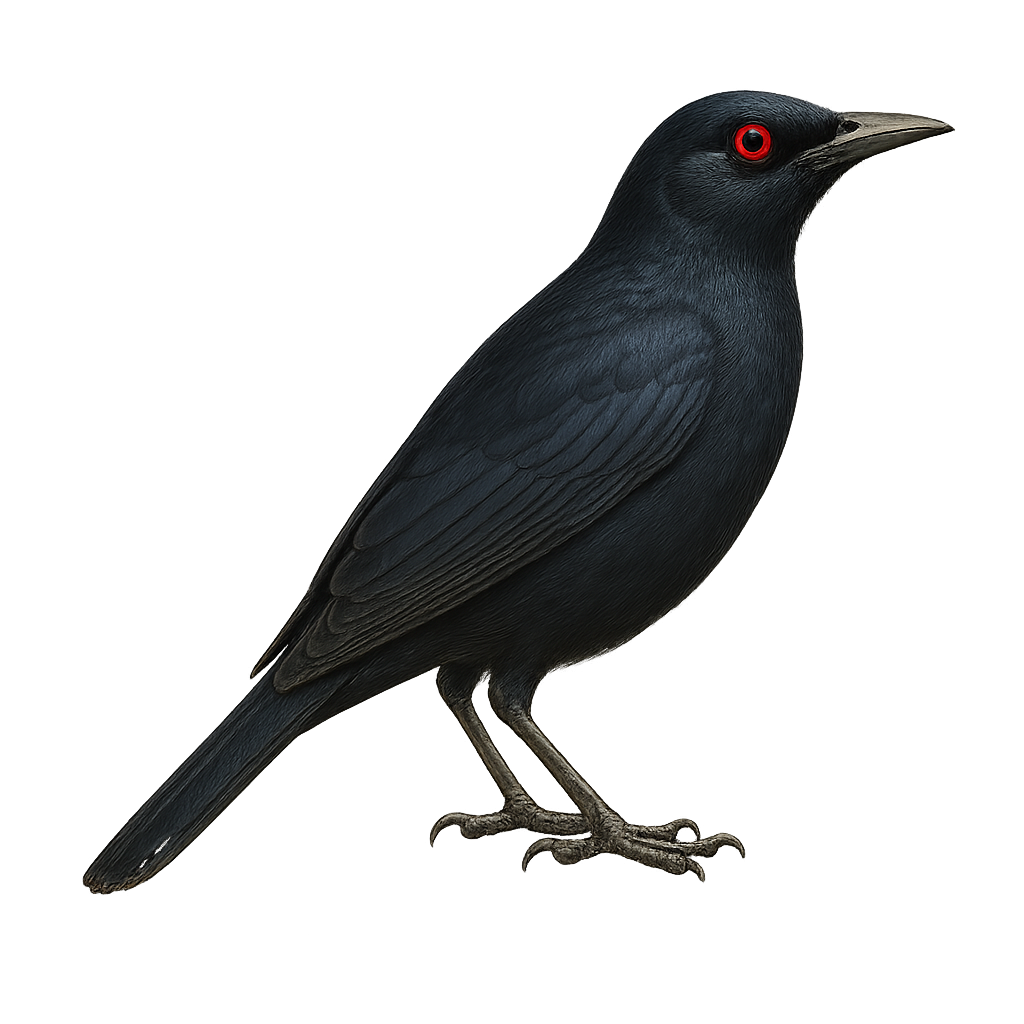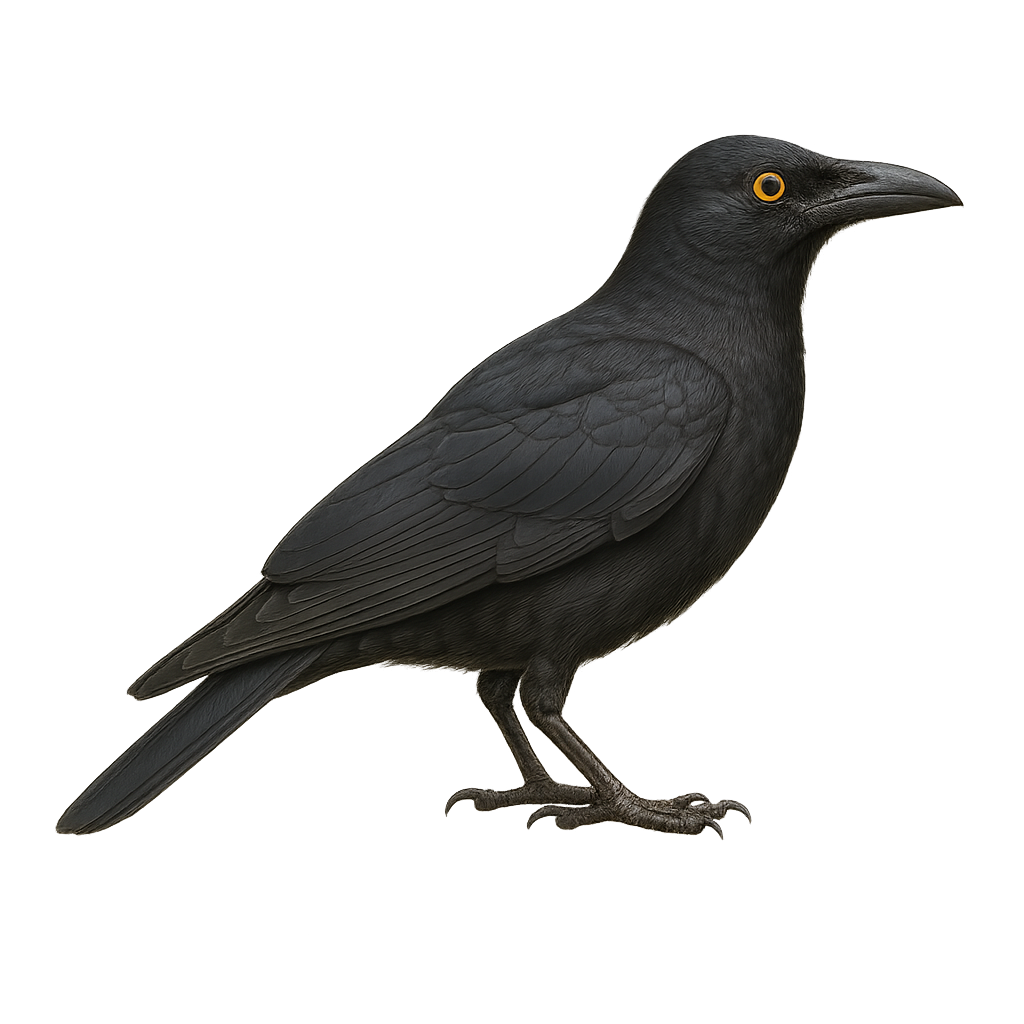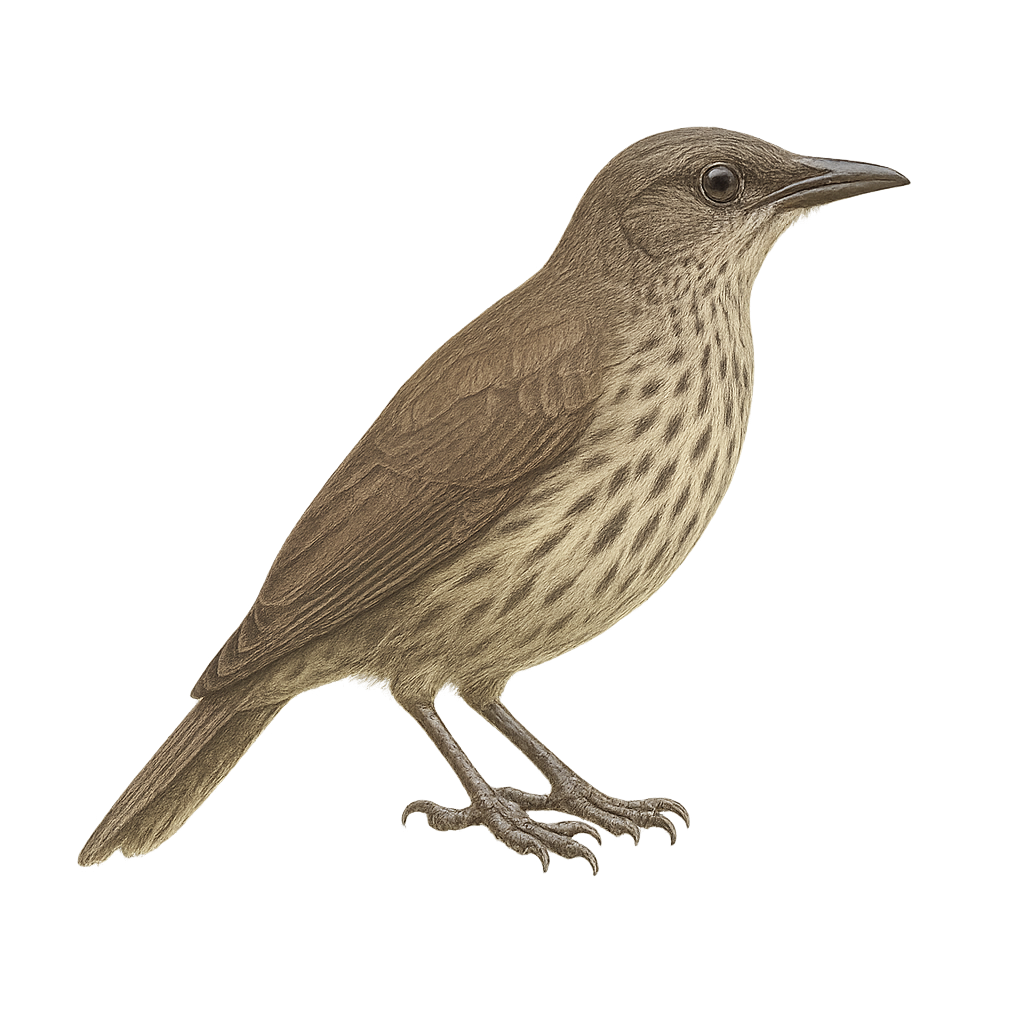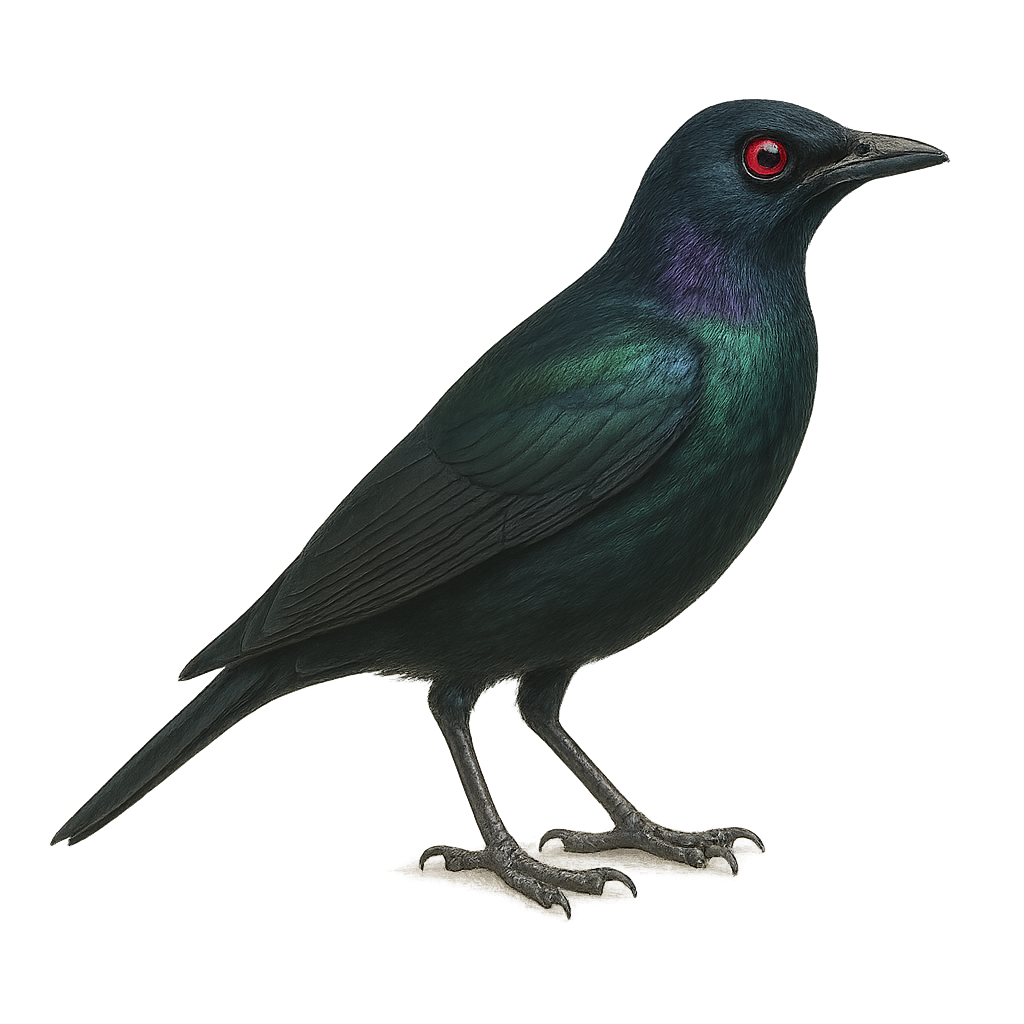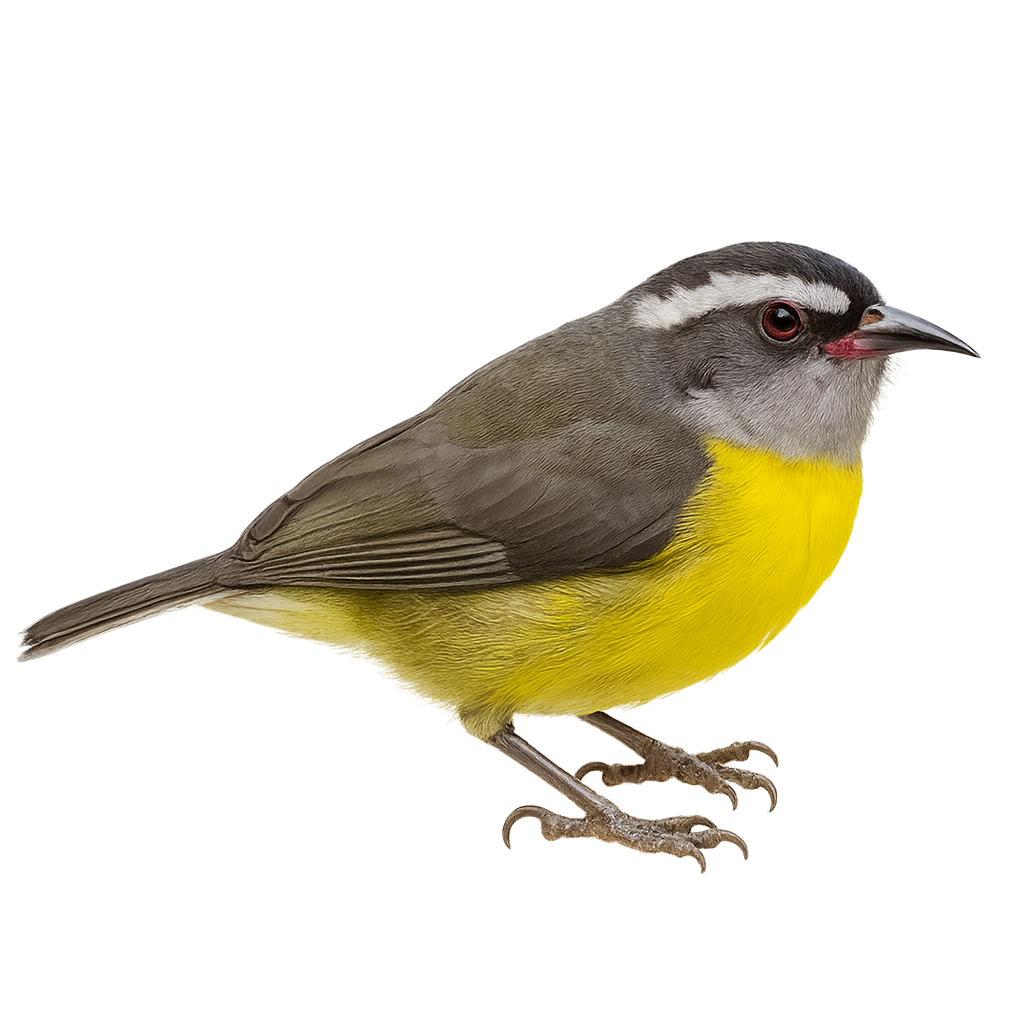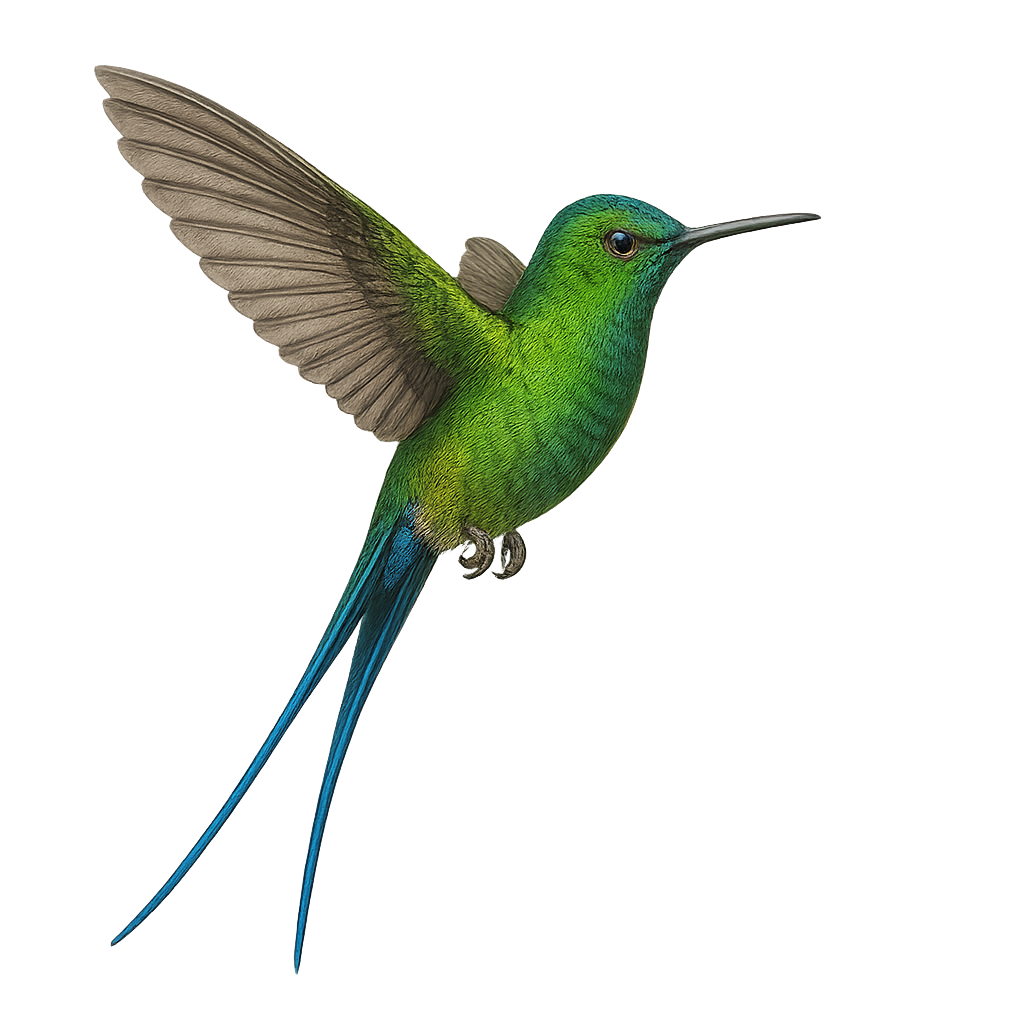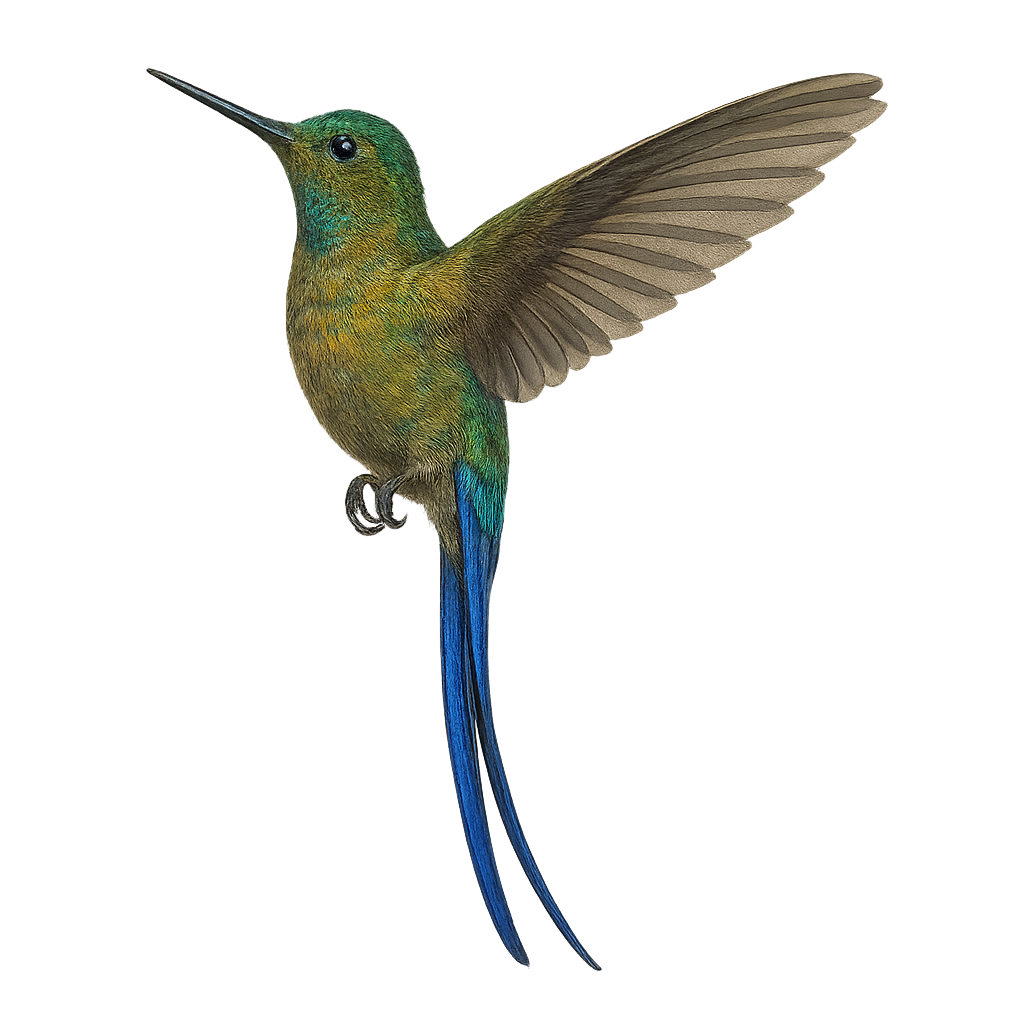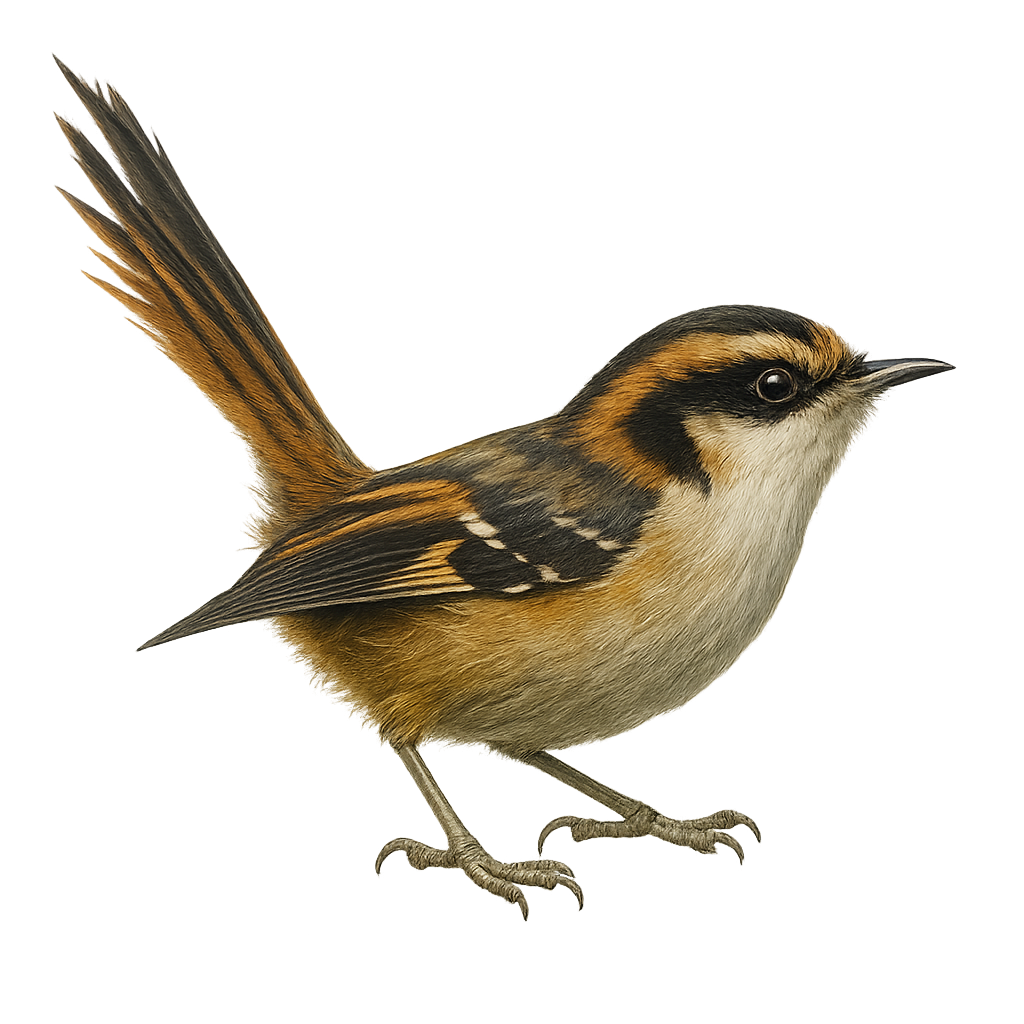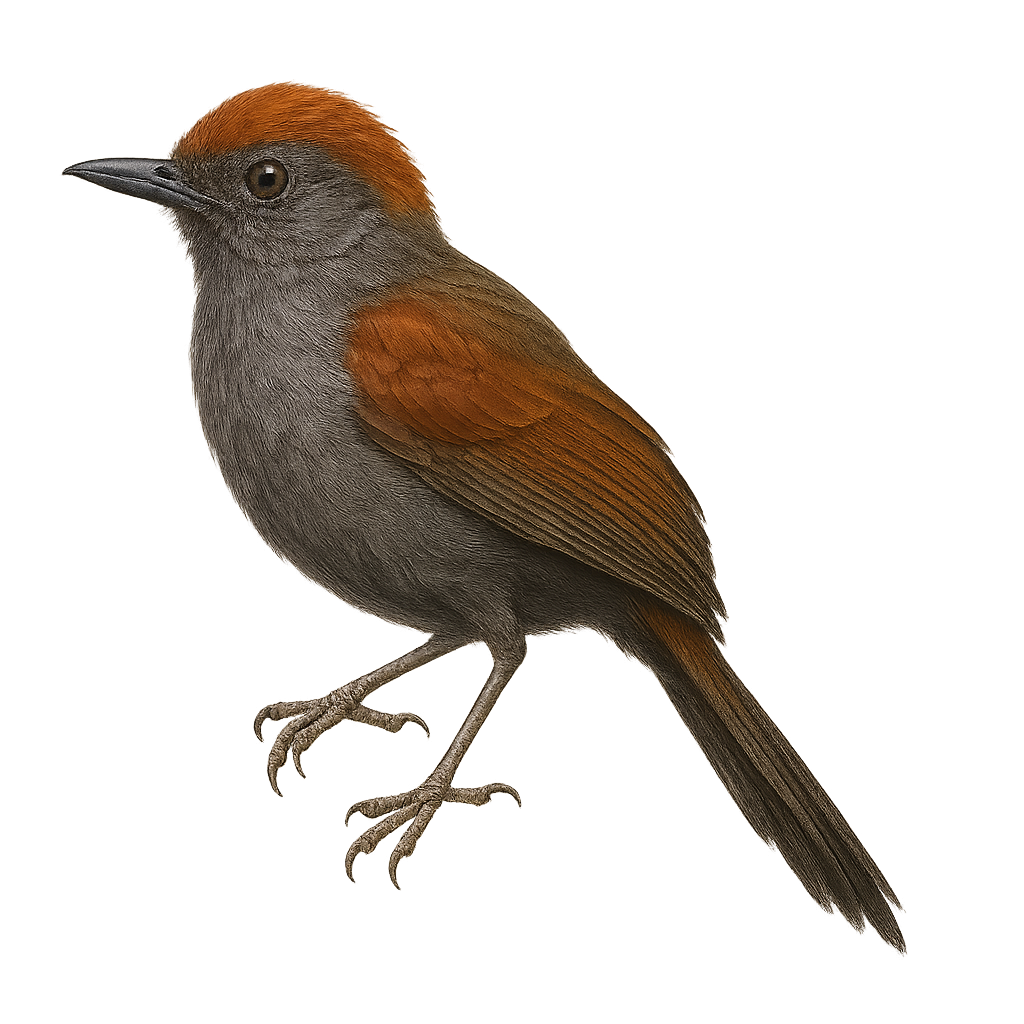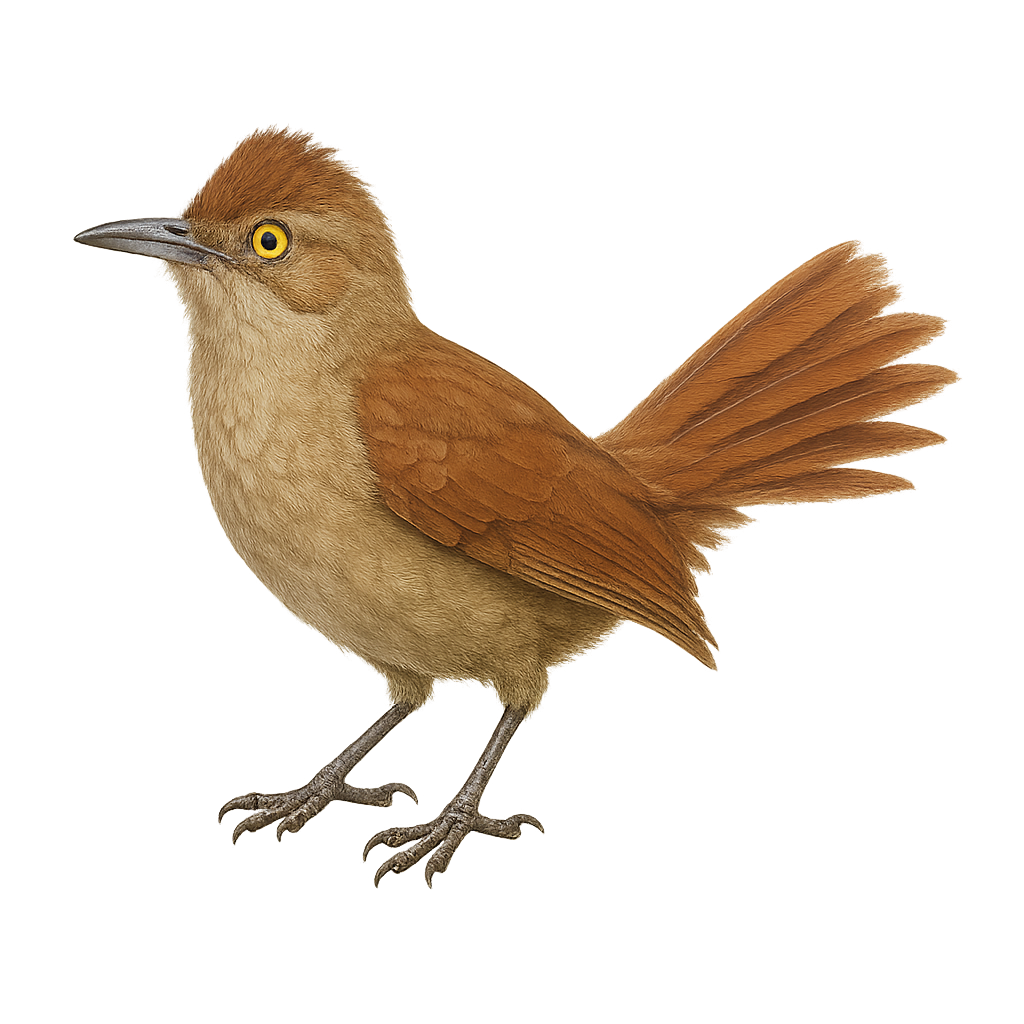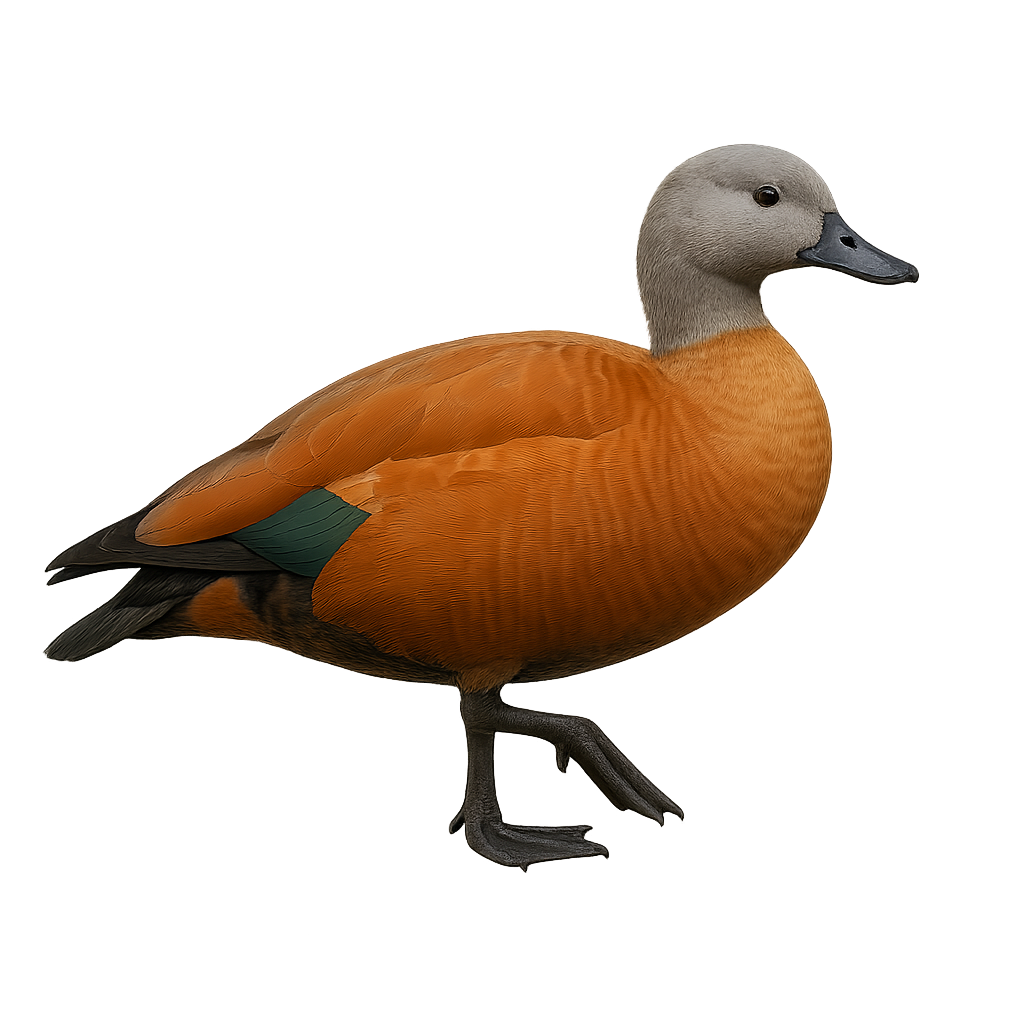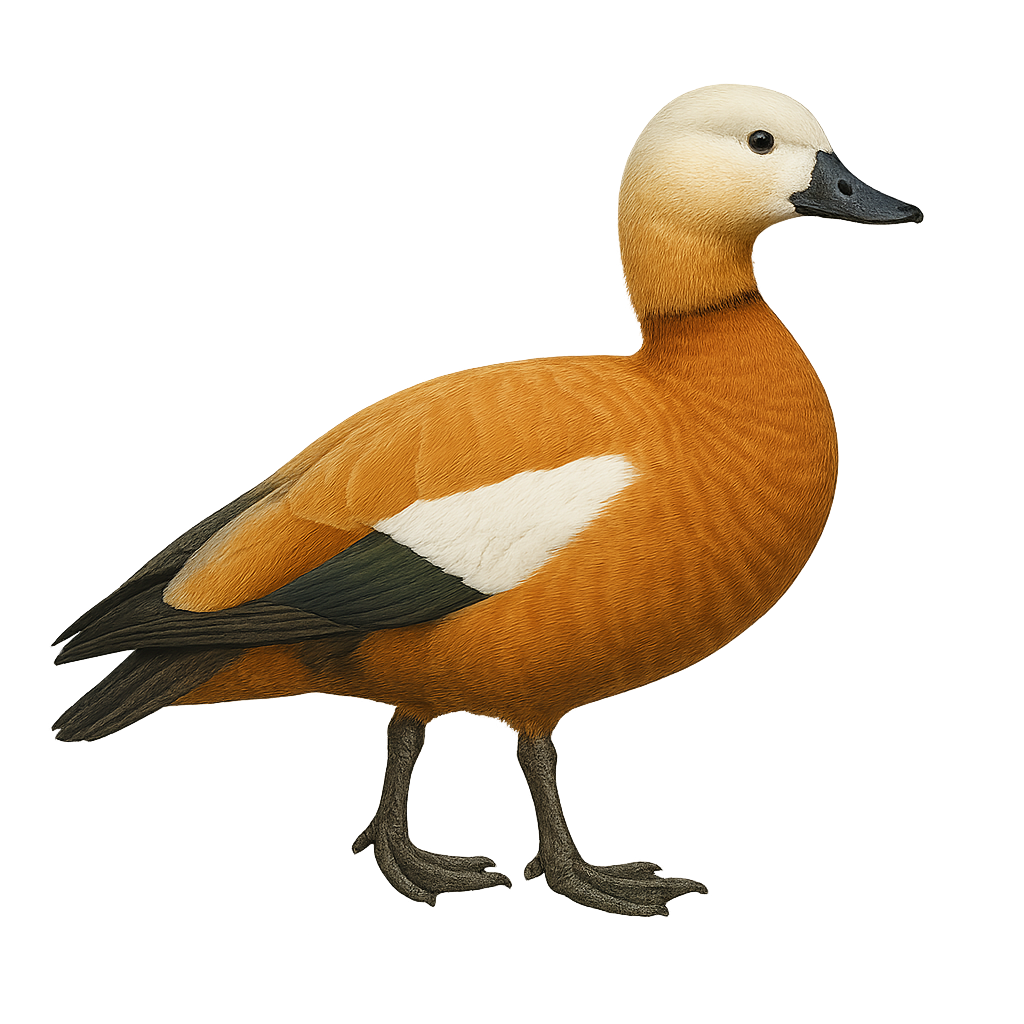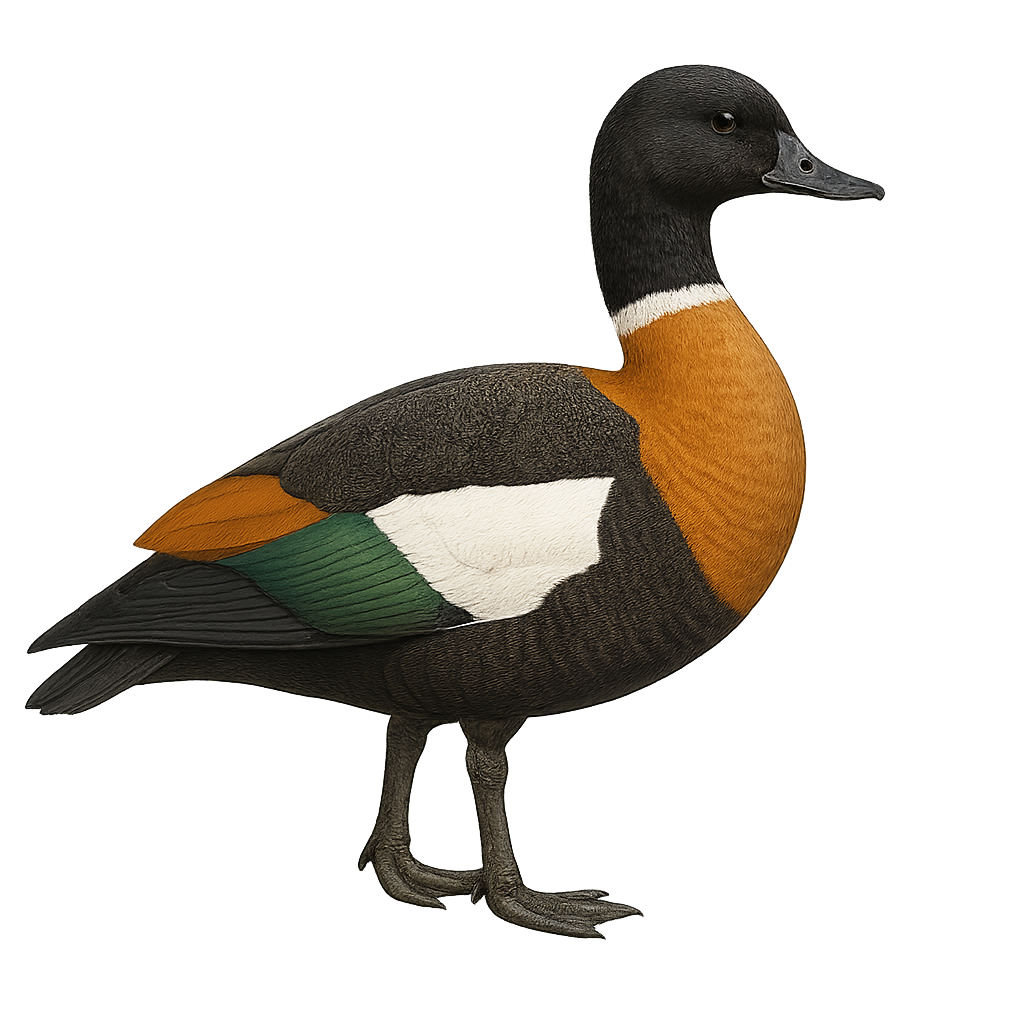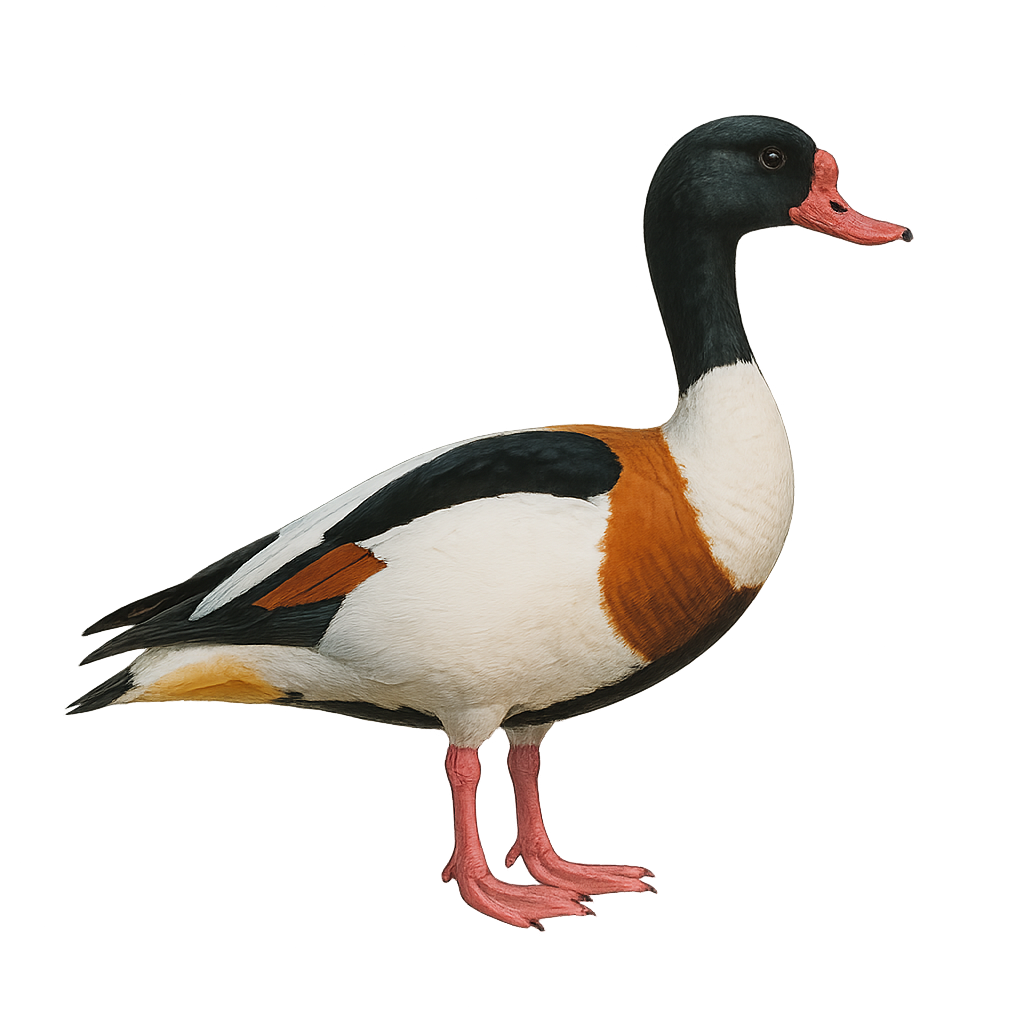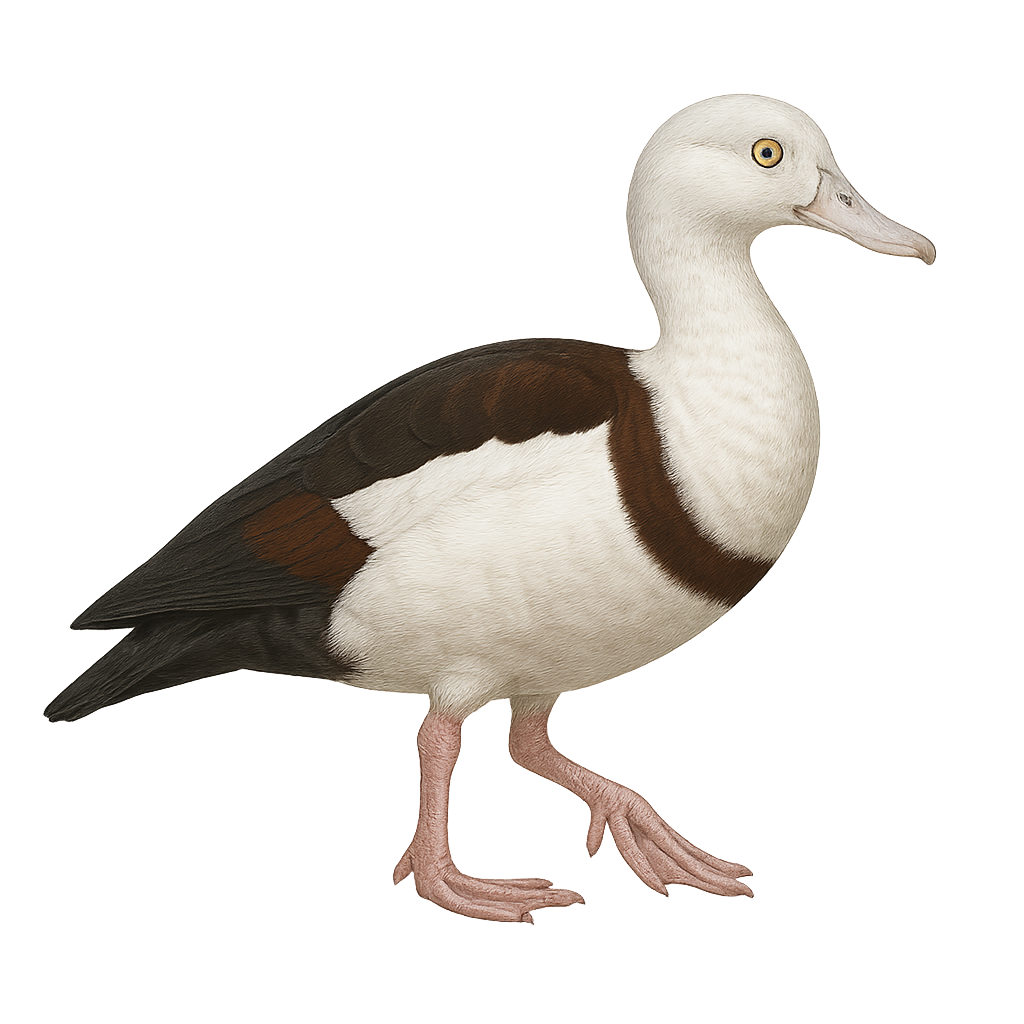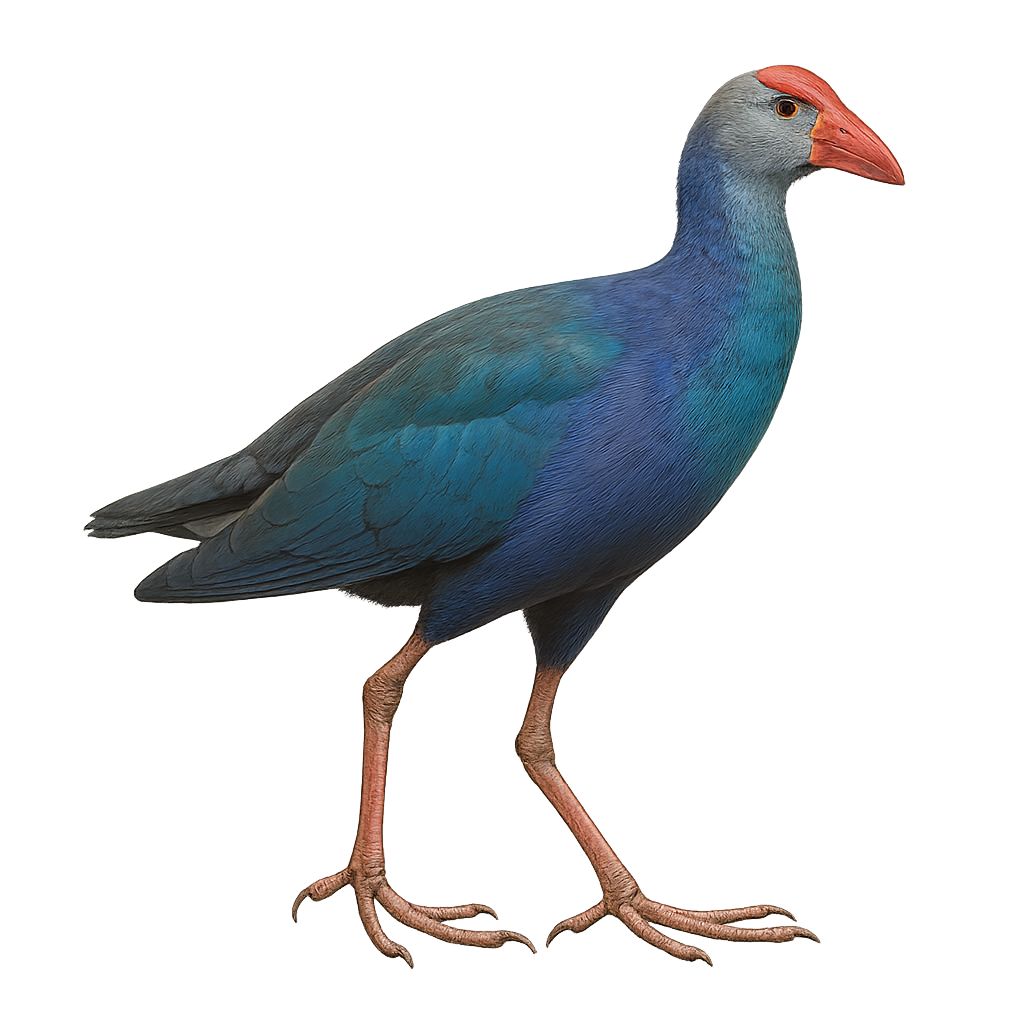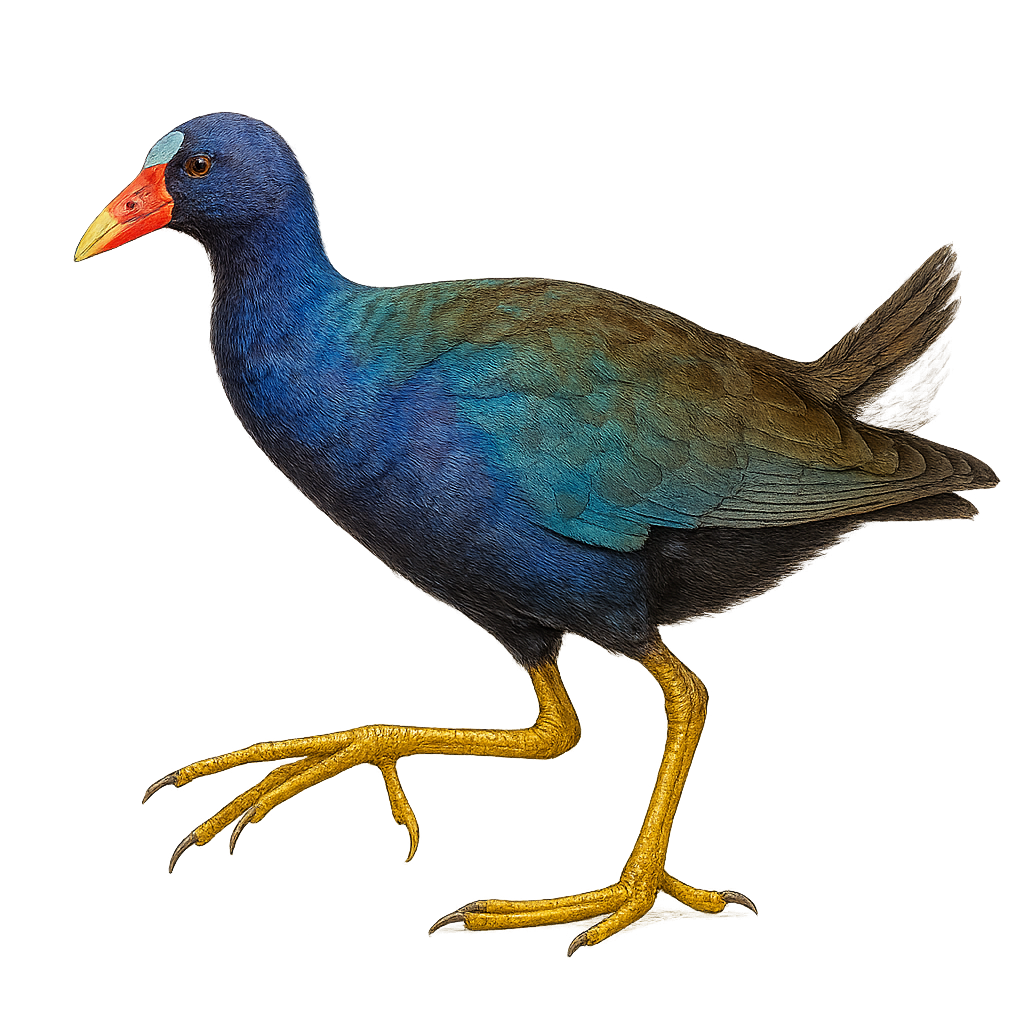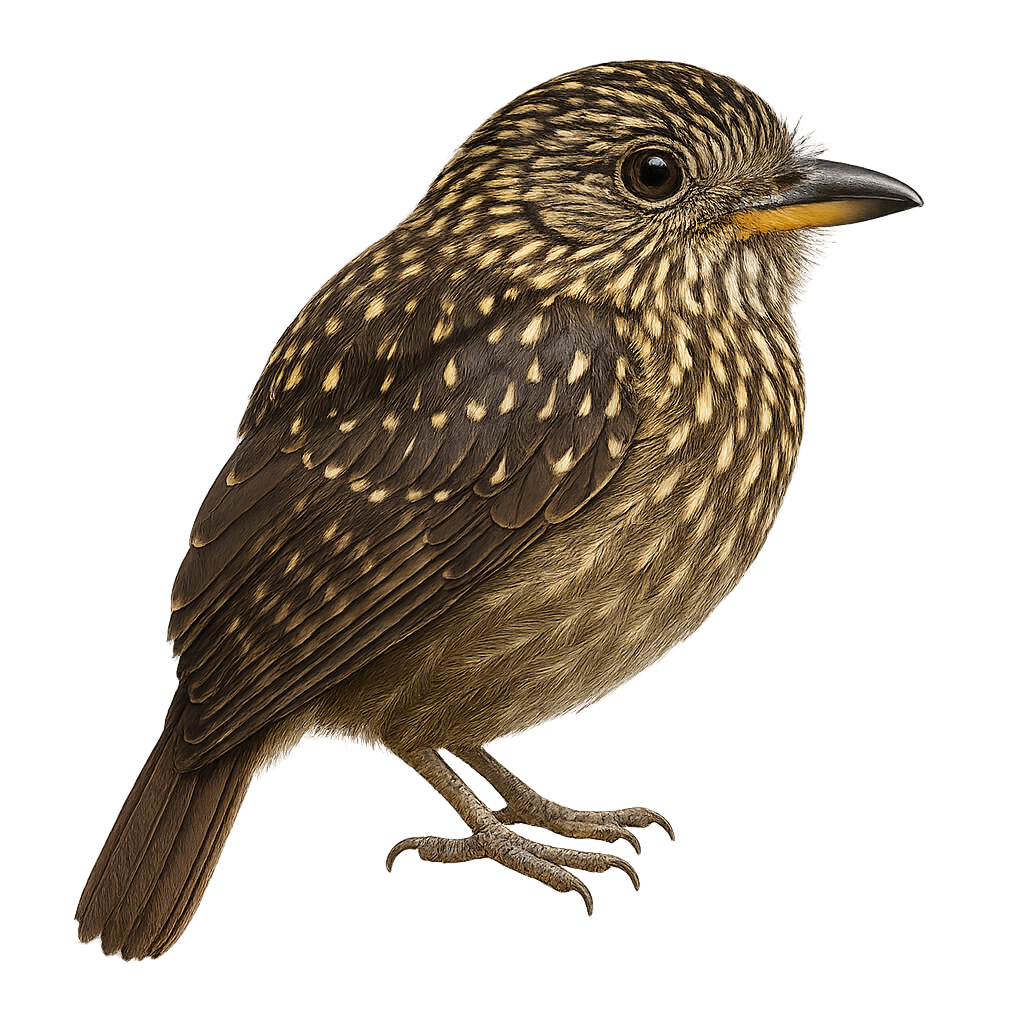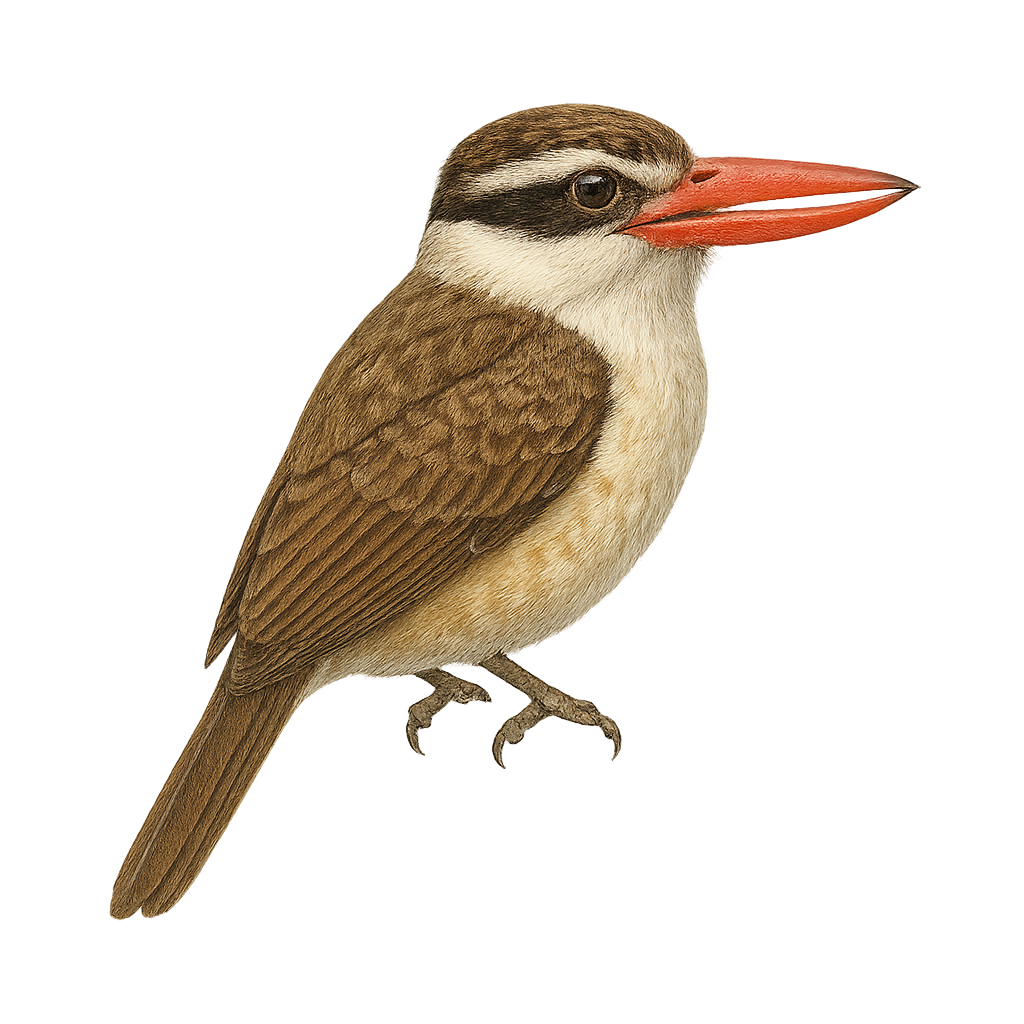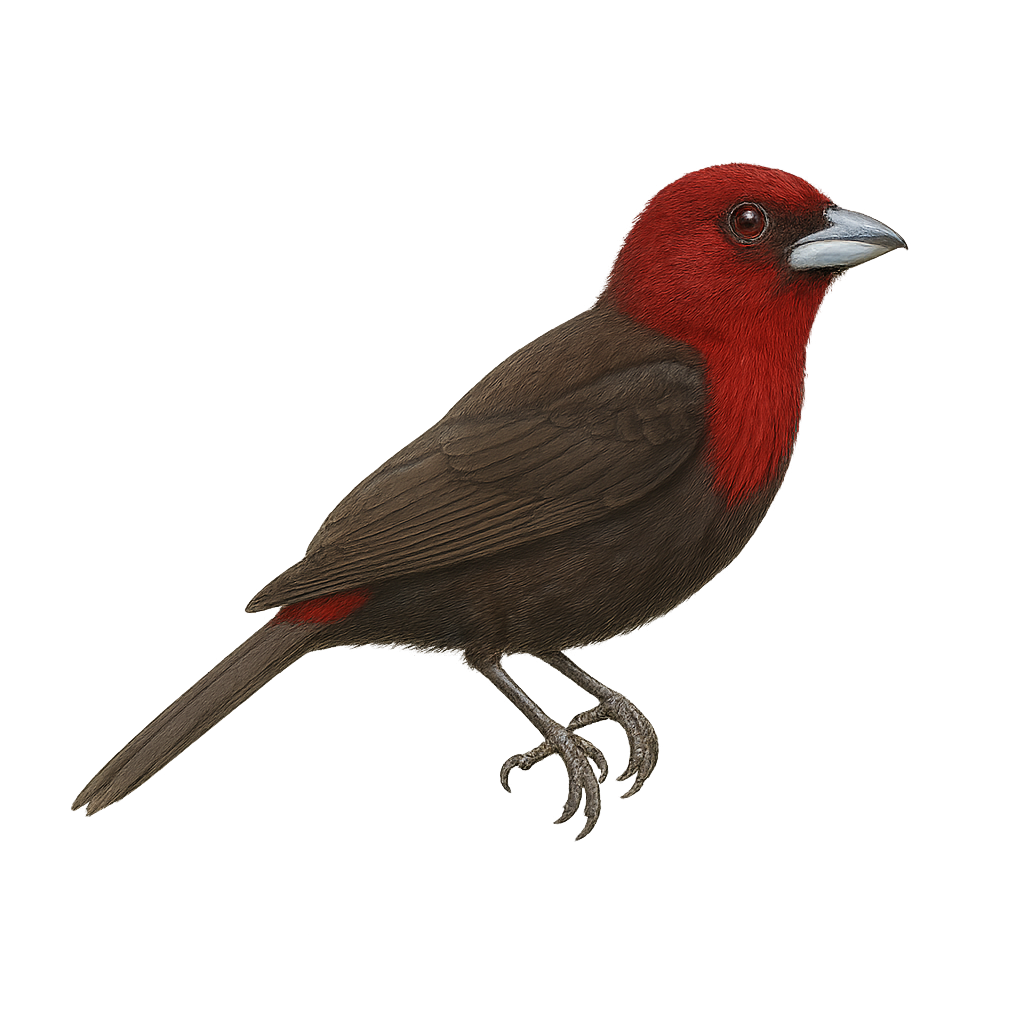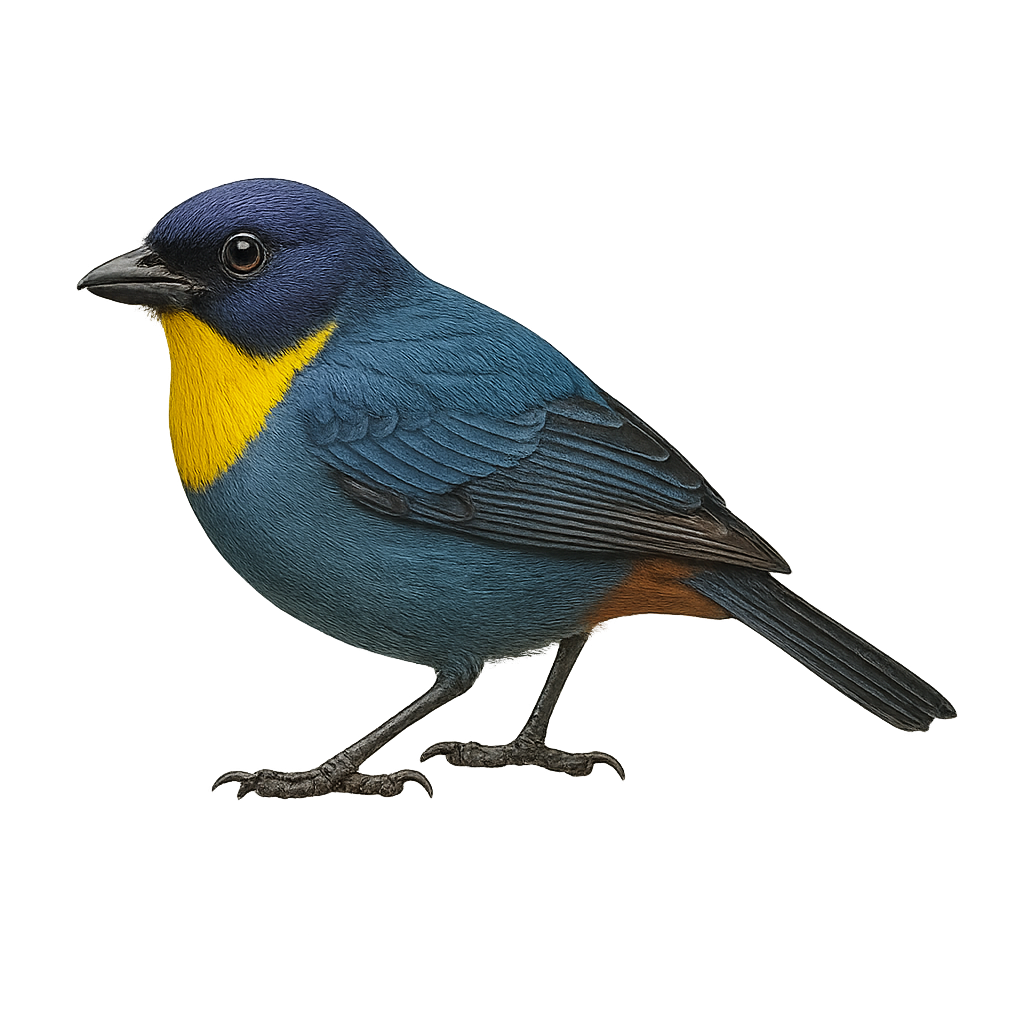The Arctic Tern is a migratory bird species primarily found in coastal regions of the Arctic during the summer, and in tropical and subtropical areas during the winter. It measures about 35 to 40 cm in length, with a wingspan of 80 to 100 cm, and weighs between 90 and 130 g. Its plumage is mostly white with gray tones on the back and wings, and its head is black with a distinctive black band around the eyes. The Arctic Tern is famous for its impressive migrations, traveling thousands of kilometers between its breeding sites in the Arctic and its wintering grounds in Africa, Southeast Asia, and Australia. It primarily feeds on fish and marine invertebrates, which it catches by diving into the water. While its population remains stable, the Arctic Tern is threatened by habitat loss, human disturbances, and climate change.
The Caspian Tern, Hydroprogne caspia, is the largest tern species, easily identified by its bright red bill and black cap. It inhabits coasts, lakes, and rivers, feeding mainly on fish caught through agile diving. Its flight is strong and direct, often accompanied by harsh calls. It nests in colonies on islands or sandy beaches, typically laying two to three eggs. Although widespread, it is sensitive to human disturbance and habitat degradation. Its population is stable but remains vulnerable to environmental changes.
The Sandwich Tern, Sterna sandvicensis, is an elegant seabird known for its white plumage, black cap, and black bill with a yellow tip. It inhabits European and African coasts, nesting in colonies on beaches, islands, and lagoons. It primarily feeds on fish, which it catches by skillfully diving. As a migratory bird, it travels long distances between breeding sites and wintering grounds. The Sandwich Tern is an indicator of coastal ecosystem health, and its conservation is vital in the face of threats like pollution and human disturbance.
The Roseate Tern is an elegant seabird, recognizable by its pure white plumage, graceful wings, and black bill with a red tip. It frequents coasts and islands, often nesting in colonies on sandy beaches or rocky islets. Its flight is agile and fast, often punctuated by spectacular dives to catch fish at the water's surface. A migratory bird, it travels long distances between its breeding sites in Europe and its wintering grounds in Africa or South America. The Roseate Tern is a protected species, as it is vulnerable to human disturbances and predation by introduced species.
The Sooty Tern, or Onychoprion fuscatus, is a medium-sized tern known for its striking black and white plumage. Its upper parts are predominantly black, while the underparts are white, creating a sharp contrast. The black, slender bill is well-suited for its diet of fish and squid. Sooty Terns are gregarious seabirds, often seen in large flocks, especially during the breeding season. They nest mainly on tropical and subtropical islands, forming extensive colonies. Their flight is swift and agile, characterized by rapid wing beats and graceful glides. Although they spend most of their lives at sea, they return to land to breed, typically laying a single egg per season.
The common tern is an elegant seabird easily recognized by its white plumage, light gray back, and bright red beak. It is primarily found along the coasts of Europe, Asia, and North Africa, often near estuaries and rivers. This bird is an excellent fisher, diving with precision into the water to catch fish. The common tern is also known for its swift and graceful flights.
The Royal Tern, or Thalasseus maximus, is an elegant seabird known for its large size and striking white plumage, contrasted by a black cap on its head. Its bright orange bill and long, slender wings give it a majestic appearance in flight. It primarily inhabits Atlantic coasts and estuaries, feeding on fish caught with precision diving. Sociable by nature, it nests in dense colonies on sandy islets or isolated beaches. Although its conservation status is currently "least concern," it remains sensitive to human disturbances and habitat degradation.
The Freckled Duck, Stictonetta naevosa, is a waterfowl species endemic to Australia. Recognizable by its brown plumage speckled with white, it has a stocky build and a broad, flat bill. Males and females are similar, although males display a reddish bill during the breeding season. This duck prefers freshwater habitats such as lakes, marshes, and rivers, where it feeds mainly on aquatic plants and invertebrates. Although generally discreet, it can form small groups outside the breeding season. Its conservation status is concerning due to habitat loss and climate change, though it is not yet considered threatened.
The Micronesian Starling, or Aplonis pelzelni, is a bird endemic to the Micronesian islands. This medium-sized passerine features a glossy black plumage with metallic sheens, making it particularly attractive to observe. It is often seen in small groups, feeding mainly on fruits, insects, and nectar. Its song is melodious and varied, contributing to the soundscape of the tropical forests it inhabits. Although relatively tolerant of human presence, its population is threatened by deforestation and the introduction of invasive species. Conservation efforts are crucial to preserving this unique bird and its natural habitat.
The Micronesian Starling, scientifically known as Aplonis opaca, is a medium-sized bird in the Sturnidae family. It is predominantly found in the islands of Micronesia, inhabiting diverse environments from dense forests to urban areas. This passerine is notable for its glossy black plumage with metallic sheen and bright yellow eyes. It is omnivorous, feeding on fruits, insects, and occasionally small vertebrates. Its song is varied and melodious, often heard at dawn and dusk. Although generally sociable, it can become territorial during the breeding season.
The Polynesian Starling, or Aplonis tabuensis, is a medium-sized bird belonging to the Sturnidae family. It is primarily found in the islands of Polynesia, where it inhabits tropical forests, mangroves, and wooded areas. This bird is distinguished by its dark, glossy plumage, often black with metallic sheens. Known for its adaptability, it thrives even in disturbed habitats. The Polynesian Starling is a sociable bird, often seen in small groups. Its diet is varied, including fruits, insects, and sometimes small vertebrates. Although its conservation status is currently "least concern," monitoring its populations is essential due to potential threats such as deforestation and invasive species.
The Aplonis grandis, or San Cristobal Starling, is a bird endemic to the Solomon Islands, particularly San Cristobal Island. It is distinguished by its glossy black plumage and bright red eyes, making it easily identifiable. This bird measures about 24 to 26 cm in length and primarily feeds on fruits and insects. It is often observed in small groups, moving through tropical rainforests and wooded areas. Although its habitat is limited, it adapts well to environmental changes, allowing it to maintain a stable population. However, deforestation poses a potential threat to its natural habitat.
The Bananaquit, or Coereba flaveola, is a small songbird belonging to the Thraupidae family. It is easily recognizable by its black upperparts and bright yellow underparts, with a distinctive white stripe above the eye. This bird is widely distributed across the Caribbean, Central, and South America. It inhabits various environments, from tropical forests to urban gardens. The Bananaquit is an active and curious bird, often seen feeding on nectar, fruits, and insects. It uses its slender, curved bill to access flower nectar, playing a crucial role in pollination.
The Long-tailed Sylph is a captivating hummingbird, easily recognized by its long, iridescent blue-green tail and vibrant plumage. It primarily inhabits the humid forests and forest edges of the Andes, where it feeds on nectar and insects. This hummingbird is a master of hovering flight, allowing it to feed efficiently from flowers. Males are particularly notable for their spectacular tails, used to attract females. Although generally solitary, this bird can be seen in small groups during the breeding season. Its song is a gentle chirping, often heard at dawn.
The Violet-tailed Sylph, Aglaiocercus coelestis, is a captivating hummingbird found in the humid forests of western Ecuador and Colombia. This small bird boasts a dazzling plumage with shades of emerald green and metallic blue, and a long, elegant tail that gives it a graceful appearance. Males are distinguished by their longer tails and more vibrant colors compared to females. They primarily feed on nectar but also consume small insects to supplement their diet. Their rapid and agile flight allows them to move easily between flowers, playing a crucial role in pollination.
The Thorn-tailed Rayadito, or Aphrastura spinicauda, is a small bird endemic to the temperate forests of southern South America, particularly in Chile and Argentina. It measures about 14 cm in length and is distinguished by its long, spiny tail, which gives it its name. Its plumage is primarily brown with shades of rufous and black, and it features a distinctive white stripe above the eye. This bird is often seen moving nimbly through branches in search of insects and spiders, which make up the bulk of its diet. Known for its social nature, it is often spotted in small groups or pairs, and is recognized for its melodious and complex song.
The Pale-breasted Spinetail is a small bird from the Furnariidae family, primarily found in South America. It is characterized by its reddish-brown plumage and lighter, almost white breast. This bird is often seen in dense undergrowth and secondary forests, where it moves nimbly in search of food. It primarily feeds on insects and small invertebrates, which it finds by foraging through foliage and low branches. The Pale-breasted Spinetail is known for its distinctive song, a series of rapid, repetitive trills that echo through its habitat. Although relatively common within its range, it remains elusive and difficult to spot due to its wary behavior and preference for densely vegetated areas.
The McConnell's Spinetail is a small bird from the Furnariidae family, primarily found in the humid forests and wooded areas of South America, particularly in Venezuela, Guyana, and Brazil. It is characterized by its reddish-brown plumage and long, tapered tail. This bird is often seen in pairs or small groups, actively moving through foliage in search of insects and other small invertebrates. Although discreet, its high-pitched, repetitive song often betrays its presence. The McConnell's Spinetail is a resilient bird, capable of adapting to various habitats, yet it remains sensitive to deforestation and the loss of its natural habitat.
The Rufous-fronted Thornbird, or Phacellodomus ruber, is a bird from the Furnariidae family, primarily found in South America. It is identifiable by its reddish-brown plumage and long, tapered tail. This bird measures about 18 to 20 cm in length and weighs between 20 and 30 grams. It is often seen in dry forests, savannas, and shrublands, where it builds elaborate dome-shaped nests with twigs. The Rufous-fronted Thornbird is a social bird, often seen in pairs or small groups. Its song is a fast, repetitive trill used to mark its territory. Although not threatened, deforestation could impact its natural habitats.
The South African Shelduck, or Tadorna cana, is a medium-sized duck known for its greyish head and reddish-brown plumage. Males and females exhibit marked sexual dimorphism, with males having a lighter head. They primarily inhabit the wetlands of southern Africa, including South Africa, Lesotho, and Namibia. These birds prefer lakes, marshes, and rivers but can also be found in open grasslands. They are often seen in pairs or small groups. Their diet mainly consists of aquatic plants, insects, and small invertebrates. Although their population is stable, they are sometimes threatened by habitat loss and hunting.
The Ruddy Shelduck, or Tadorna ferruginea, is a medium-sized waterfowl known for its striking orange-brown plumage and pale head. Males and females look similar, though males have a black neck ring during the breeding season. This bird favors open habitats near freshwater, such as lakes and rivers. It is primarily herbivorous, feeding on aquatic plants, but may also eat insects and small invertebrates. The Ruddy Shelduck is a partial migrant, moving southward in winter. It is often seen in pairs or small groups and is known for its distinctive, melodious call.
The Radjah Shelduck, scientifically known as Tadorna tadornoides, is a medium-sized waterfowl distinguished by its striking white plumage and distinctive black markings on its wings and back. Native to Australia and New Guinea, it primarily inhabits wetlands, marshes, and rivers. This duck is often seen in pairs or small groups, feeding on aquatic plants, insects, and small crustaceans. Its breeding season typically coincides with the rainy season, providing a resource-rich environment for raising its young. The Radjah Shelduck is appreciated for its beauty and relatively tolerant behavior, making it a favored subject for wildlife photographers.
The Common Shelduck is a large duck with a distinctive plumage, measuring between 58 and 67 cm in length. It is identified by its glossy greenish-black head, white body with a broad chestnut band, and bright red bill. Males have a prominent knob at the base of the bill, which females lack. This species inhabits estuaries, lagoons, salt marshes, tidal mudflats, and shallow lake shores, often in flocks. It nests in burrows or cavities, sometimes dug into dunes or embankments. The shelduck primarily feeds on aquatic invertebrates such as mollusks, worms, and crustaceans, filtered from the mud. While generally secure, it is vulnerable to coastal wetland destruction.
The Radjah Shelduck, scientifically known as Radjah radjah, is an elegant and distinctive waterbird primarily found in coastal regions and wetlands of Australia and New Guinea. It is characterized by its pure white plumage, contrasting with a black band on the wings and a pinkish hue on the bill. This duck prefers freshwater and brackish environments and is often seen in pairs or small groups. Although relatively tolerant, it remains vigilant against potential threats. The Radjah Shelduck feeds mainly on aquatic plants, insects, and small invertebrates. Its breeding season varies by region but is generally influenced by rainfall and resource availability.
The Purple Swamphen, or Porphyrio porphyrio, is a striking waterbird known for its vivid blue-purple plumage and bright red bill. It primarily inhabits marshes, lakes, and wetlands with dense vegetation. This bird is recognized for its graceful walk and swimming ability. The Purple Swamphen is omnivorous, feeding on aquatic plants, insects, and small animals. It is often seen walking on water lilies thanks to its long toes. Although generally discreet, it can be noisy, emitting loud and varied calls. Its presence is an indicator of healthy aquatic ecosystems.
The Purple Gallinule, or Porphyrio martinica, is a striking waterbird known for its vivid colors. It features a bright blue-purple plumage, a red bill with a yellow tip, and long yellow legs. This species is primarily found in marshes, ponds, and wetlands of Central and South America, as well as the southern United States. It is known for its ability to walk on floating vegetation due to its long toes. The Purple Gallinule is a social bird, often seen in small groups. It feeds mainly on aquatic plants, insects, and small invertebrates. Its breeding period varies by region but is generally active during the warmer months.
The Dusky-cheeked Puffbird, or Malacoptila fusca, is a discreet bird found in the tropical forests of South America. It is characterized by its dark brown plumage, with lighter shades on the belly and a slightly darker head. This bird measures about 18 to 20 cm in length and has a robust beak, well-suited for its diet mainly consisting of insects and small fruits. It is often seen alone or in pairs, perched motionless on a low branch, watching for prey. Its song is soft and melodious, often heard at dawn or dusk. Although its habitat is threatened by deforestation, it remains relatively common in some areas.
The White-eared Puffbird, scientifically known as Nystalus chacuru, is a medium-sized bird belonging to the Bucconidae family. It is characterized by its brown and white plumage, with a distinctive white band on the forehead and around the eyes. This bird is primarily found in South America, particularly in Brazil, Bolivia, and Paraguay. It inhabits dry forests, savannas, and open wooded areas. The White-eared Puffbird is an opportunistic predator, feeding mainly on insects and small vertebrates. It is known for its melodious and repetitive song, often heard at dawn. Although relatively tolerant of human presence, it prefers habitats with dense vegetation, providing protection from predators.
The Silver-beaked Tanager, or Ramphocelus carbo, is a medium-sized bird known for its striking plumage. The male features a bright red back contrasting with a black belly, while the female displays more subdued tones. It is primarily found in the humid tropical forests of South America, particularly in the Amazon. This bird is often seen in small groups, feeding on fruits and insects. Its melodious song and vibrant colors make it a favorite among birdwatchers and photographers. Although relatively common, deforestation threatens its natural habitat. The Silver-beaked Tanager plays a crucial role in seed dispersal, aiding forest regeneration.
The Purplish-mantled Tanager, scientifically known as Iridosornis porphyrocephalus, is a vibrant bird belonging to the Thraupidae family. It inhabits the humid forests of the Andes, where its striking plumage stands out. The bird's head is a distinctive purplish hue, contrasting with a body of blue and green shades. It measures about 15 cm in length and weighs between 20 and 30 grams. Its diet consists mainly of insects and fruits found in the dense canopy. Although discreet, it is often detected by its melodious song. The Purplish-mantled Tanager is an important indicator of the health of Andean forest ecosystems, and its presence signifies a rich and preserved biodiversity.



